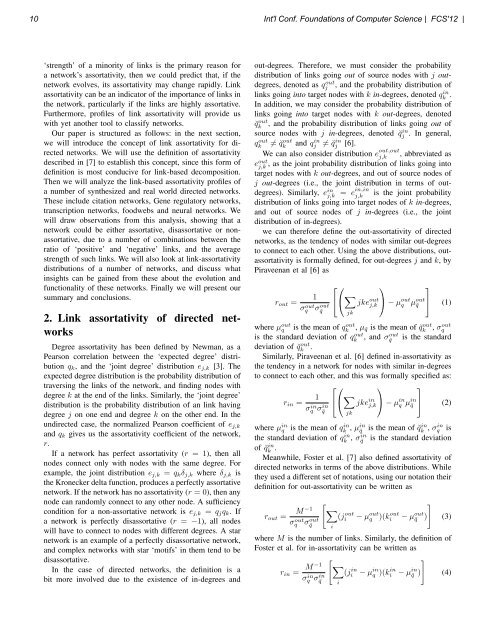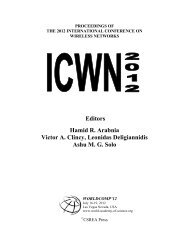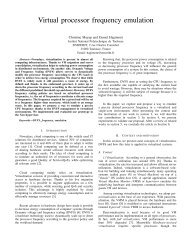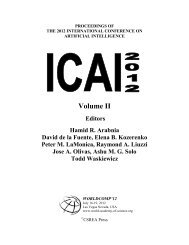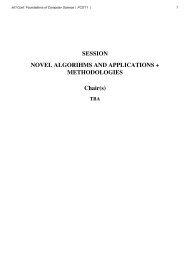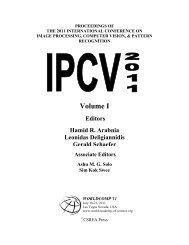SESSION GRAPH BASED AND TREE METHODS + RELATED ...
SESSION GRAPH BASED AND TREE METHODS + RELATED ...
SESSION GRAPH BASED AND TREE METHODS + RELATED ...
- TAGS
- graph
- methods
- world-comp.org
Create successful ePaper yourself
Turn your PDF publications into a flip-book with our unique Google optimized e-Paper software.
10 Int'l Conf. Foundations of Computer Science | FCS'12 |<br />
‘strength’ of a minority of links is the primary reason for<br />
a network’s assortativity, then we could predict that, if the<br />
network evolves, its assortativity may change rapidly. Link<br />
assortativity can be an indicator of the importance of links in<br />
the network, particularly if the links are highly assortative.<br />
Furthermore, profiles of link assortativity will provide us<br />
with yet another tool to classify networks.<br />
Our paper is structured as follows: in the next section,<br />
we will introduce the concept of link assortativity for directed<br />
networks. We will use the definition of assortativity<br />
described in [7] to establish this concept, since this form of<br />
definition is most conducive for link-based decomposition.<br />
Then we will analyze the link-based assortativity profiles of<br />
a number of synthesized and real world directed networks.<br />
These include citation networks, Gene regulatory networks,<br />
transcription networks, foodwebs and neural networks. We<br />
will draw observations from this analysis, showing that a<br />
network could be either assortative, disassortative or nonassortative,<br />
due to a number of combinations between the<br />
ratio of ‘positive’ and ‘negative’ links, and the average<br />
strength of such links. We will also look at link-assortativity<br />
distributions of a number of networks, and discuss what<br />
insights can be gained from these about the evolution and<br />
functionality of these networks. Finally we will present our<br />
summary and conclusions.<br />
2. Link assortativity of directed networks<br />
Degree assortativity has been defined by Newman, as a<br />
Pearson correlation between the ‘expected degree’ distribution<br />
qk, and the ‘joint degree’ distribution ej,k [3]. The<br />
expected degree distribution is the probability distribution of<br />
traversing the links of the network, and finding nodes with<br />
degree k at the end of the links. Similarly, the ‘joint degree’<br />
distribution is the probability distribution of an link having<br />
degree j on one end and degree k on the other end. In the<br />
undirected case, the normalized Pearson coefficient of ej,k<br />
and qk gives us the assortativity coefficient of the network,<br />
r.<br />
If a network has perfect assortativity (r = 1), then all<br />
nodes connect only with nodes with the same degree. For<br />
example, the joint distribution ej,k = qkδj,k where δj,k is<br />
the Kronecker delta function, produces a perfectly assortative<br />
network. If the network has no assortativity (r = 0), then any<br />
node can randomly connect to any other node. A sufficiency<br />
condition for a non-assortative network is ej,k = qjqk. If<br />
a network is perfectly disassortative (r = −1), all nodes<br />
will have to connect to nodes with different degrees. A star<br />
network is an example of a perfectly disassortative network,<br />
and complex networks with star ‘motifs’ in them tend to be<br />
disassortative.<br />
In the case of directed networks, the definition is a<br />
bit more involved due to the existence of in-degrees and<br />
out-degrees. Therefore, we must consider the probability<br />
distribution of links going out of source nodes with j out-<br />
degrees, denoted as q out<br />
j , and the probability distribution of<br />
links going into target nodes with k in-degrees, denoted q in<br />
k .<br />
In addition, we may consider the probability distribution of<br />
links going into target nodes with k out-degrees, denoted<br />
˘q out<br />
k , and the probability distribution of links going out of<br />
source nodes with j in-degrees, denoted ˘q in<br />
j . In general,<br />
qout k ̸= ˘q out<br />
k and qin j ̸= ˘q in<br />
j [6].<br />
We can also consider distribution e out,out<br />
j,k , abbreviated as<br />
eout j,k , as the joint probability distribution of links going into<br />
target nodes with k out-degrees, and out of source nodes of<br />
j out-degrees (i.e., the joint distribution in terms of outdegrees).<br />
Similarly, ein j,k = ein,in<br />
j,k is the joint probability<br />
distribution of links going into target nodes of k in-degrees,<br />
and out of source nodes of j in-degrees (i.e., the joint<br />
distribution of in-degrees).<br />
we can therefore define the out-assortativity of directed<br />
networks, as the tendency of nodes with similar out-degrees<br />
to connect to each other. Using the above distributions, outassortativity<br />
is formally defined, for out-degrees j and k, by<br />
Piraveenan et al [6] as<br />
rout =<br />
1<br />
σout q σout ⎡⎛<br />
⎣⎝<br />
˘q<br />
∑<br />
jke out<br />
⎞<br />
⎠<br />
j,k − µ out<br />
jk<br />
q µ out<br />
˘q<br />
⎤<br />
⎦ (1)<br />
where µ out<br />
q is the mean of qout k , µ˘q is the mean of ˘q out<br />
k , σout q<br />
is the standard deviation of qout k , and σout<br />
˘q is the standard<br />
deviation of ˘q out<br />
k .<br />
Similarly, Piraveenan et al. [6] defined in-assortativity as<br />
the tendency in a network for nodes with similar in-degrees<br />
to connect to each other, and this was formally specified as:<br />
1<br />
rin =<br />
σin q σin ⎡⎛<br />
⎣⎝<br />
˘q<br />
∑<br />
jke in<br />
⎞<br />
⎠<br />
j,k − µ in<br />
q µ in<br />
⎤<br />
⎦<br />
˘q (2)<br />
jk<br />
where µ in<br />
q is the mean of qin k , µin<br />
˘q is the mean of ˘q in<br />
k , σin q is<br />
the standard deviation of qin k , σin<br />
˘q is the standard deviation<br />
of ˘q in<br />
k .<br />
Meanwhile, Foster et al. [7] also defined assortativity of<br />
directed networks in terms of the above distributions. While<br />
they used a different set of notations, using our notation their<br />
definition for out-assortativity can be written as<br />
rout =<br />
M −1<br />
σ out<br />
q σ out<br />
˘q<br />
[ ∑<br />
i<br />
(j out<br />
i<br />
− µ out<br />
q )(k out<br />
i − µ out<br />
˘q )<br />
where M is the number of links. Similarly, the definition of<br />
Foster et al. for in-assortativity can be written as<br />
[<br />
−1 M ∑<br />
rin = (j in<br />
i − µ in<br />
q )(k in<br />
i − µ in<br />
]<br />
˘q ) (4)<br />
σ in<br />
q σ in<br />
˘q<br />
i<br />
]<br />
(3)


